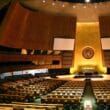The resilient nonproliferation regime
By Selim Can Sazak, November 21, 2012
It has often been argued that the Nuclear Non-Proliferation Treaty (NPT) has failed, is failing, or is destined to fail. Beneath such defeatist attitudes is the idea that the treaty is a negation of history and a challenge to human psychology — that widespread proliferation is an inevitable result of mankind's increasing sophistication in weaponry and of people's fetishistic devotion to objects of power. But though the treaty has often been pronounced dead amid proliferation crises, from Osirak to Iran, it has never actually died. Rather, it has endured — and grown stronger.
In the 1960s, China and France tested their first nuclear weapons. Just a few years before 1970, the year the treaty came into force, Israel became a nuclear-armed nation. Since then, however, proliferation has slowed dramatically. Only four more countries have become nuclear-armed, and one of these, South Africa, has since renounced nuclear weapons and entered into the treaty as a non-nuclear weapon state.
Over the decades, many states could have gone nuclear, but most have chosen restraint. Studies that compare decision making in potential nuclear countries, before and after they accede to the treaty, demonstrate that proliferation activities decline once the treaty is ratified. The NPT's greatest success, however, has been in establishing nonproliferation as a permanent norm of international relations.
Admittedly, the current outlook for disarmament and nonproliferation is not without problems. Iraq, Libya, and North Korea, for example, have tried to cheat the treaty regime, and others may do so in the future. Threats such as nuclear terrorism linger, and there is always the danger that a nuclear-armed country such as Pakistan could become a failed state.
A regime's evolution. Moreover, the treaty itself is argued to be riddled with defects and loopholes. Often cited as evidence of its flawed design are the absence of a credible enforcement provision, the potential for abuse of dual-use fuel cycle technologies, and the possible misuse of withdrawal rights.
Still, the treaty has achieved astounding success despite its vulnerabilities, and has evolved to address changing threats. The Additional Protocol to the NPT, and complementary regimes like the Nuclear Suppliers Group and the Missile Technology Control Regime, were either responses to the treaty's inherent deficiencies or extensions of the regime's scope and force. These improvements provide good reason to believe that the nonproliferation regime will prove resilient in addressing whatever challenges it faces in the future.
Though the Cold War is long over, now is not the time to surrender to proliferation, but rather to oppose it more vigorously. Many measures to buttress the regime have been proposed. These include prevailing on signatories to ratify and implement the Additional Protocol, strengthening the International Atomic Energy Agency's leverage when it comes to implementing verification measures like special inspections, and systematizing the UN Security Council's role in responding to noncompliance.
Still, formal steps such as these cannot salvage a discredited regime, so preserving the regime's credibility is paramount. This requires a no-exceptions attitude from all concerned. Unfortunately, the nuclear weapon states — even as they have failed to fulfill their commitment under the treaty to pursue disarmament in good faith — have sometimes seemed eager to jettison or circumvent other aspects of the nonproliferation regime. They have selectively permitted proliferation, as evidenced by the recent nuclear cooperation agreement between the United States and India, and by relations between Russia and Iran, and China and North Korea. Such permissiveness conveys the message that the treaty is not an unconditional commitment, but rather an instrument of political leverage. Sending this message emboldens nuclear aspirants, encourages signatories to hedge their bets, and reinforces the perception that countries can get away with violating international norms.
Horizontal and vertical. If it is true that, in the words of former Secretary of State George Shultz, proliferation begets proliferation, Iran and North Korea seem the countries most likely to begin that cycle today. North Korea has tested nuclear weapons twice, though its efforts have been plagued by technical problems. Estimates vary about how long Iran might require to produce a nuclear weapon if it makes the political decision to do so, but the prospect of a nuclear Iran in any case creates great anxiety in the Middle East. These two countries could provoke a cascade of proliferation that would nearly double the number of nuclear-armed states and relegate the NPT to the dustbin of history. Some argue that Turkey and countries such as Saudi Arabia would be compelled to explore the nuclear option if Iran goes nuclear, and the same might hold true for Japan and South Korea if North Korea demonstrates a credible nuclear capability.
Though these countries have the wherewithal to develop nuclear weapons fairly swiftly, I believe that none would chart such a course. All would be inhibited by factors like export dependence, state ideology, Western orientation, or an antimilitarist culture. So I do not envision horizontal proliferation. But I do envision the possibility of vertical proliferation. If Iran were to gain a nuclear weapon, the United States might be forced to make a long-term commitment to extending nuclear deterrence to its allies in the Middle East; North Korea could force the United States to do the same in East Asia. This might prompt Russia to rush to the defense of Iran, or China to North Korea. In this scenario, the progress achieved so far in reducing nuclear arsenals could be halted or even reversed.
Not an option. Despite such threats, significant room for optimism remains. The momentum that was established in 2009 with President Obama's Prague speech on nuclear weapons offers an opportunity for international nonproliferation efforts to be stepped up. Confidence in the treaty regime could be strengthened through steadfast diplomacy, united action against treaty violators, and an unequivocal dedication to universal nonproliferation.
There can be no real peace in a world that contains launch-ready nuclear weapons. It is the responsibility of concerned citizens of all political stripes to declare that the nuclear option is not an option at all; those concerned about nonproliferation and disarmament must hold their representatives accountable.
Will the NPT survive? That depends on what people choose. The treaty is alive and well, and likely will remain so — unless those who care about its survival let it perish.
Topics: Nuclear Weapons
Share: [addthis tool="addthis_inline_share_toolbox"]














